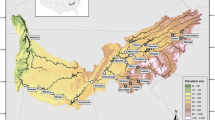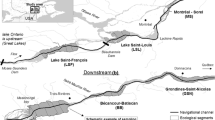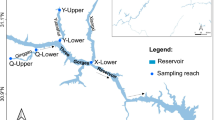Abstract
Understanding the variation of fish assemblages in reservoirs is crucial for precise interpretations of ecological processes. However, representative samples in such environments are subjected both to spatial zonation (longitudinal and transversal gradients) and limitations of fishing gears. We used a large zoned reservoir (Itaipu, Brazil) to perform a quasi-experiment that assessed the relative role of spatial gradients and fishing methods on fish diversity and composition. Active (cast nets, electrofishing and seines) and passive (gillnets and longlines) fishing gears were employed in lotic, transitional and lentic habitats of the reservoir and three large tributaries. In total 6281 individuals of 101 species were captured. Sampling methods and spatial gradients had an influence on species composition, with significant interactions between these factors. In addition, results produced by a variation partitioning analysis suggested that 21 % of the species richness was explained by the sampling methods and 7 % by the longitudinal gradient; whereas for species composition, 12 and 3 % corresponded to sampling methods and transversal gradients, respectively. Overall, our results suggest that variations among fishing gears is greater than across strong spatial gradients, emphasizing the importance of using multiple and complementary fishing methods in reservoirs for characterization of fish assemblages. The interactions between spatial gradients and sampling methods were higher with transversal than with longitudinal gradients, suggesting that substantial differences in species richness and composition among sampling gears depend to some extent on habitat. The approach used here would be applicable to any large zoned inland waterscape.





Similar content being viewed by others
References
Agostinho AA, Ferretti CML, Gomes LC, Hahn NS, Suzuki HI, Fugi R, Abujanra F (1997) Ictiofauna de dois reservatórios do rio Iguaçu em diferentes fases de colonização: Segredo e Foz do Areia. In: Agostinho AA, Gomes LC (eds) Reservatório de Segredo: bases ecológicas para o manejo. Eduem, Maringá, pp 275–292
Agostinho AA, Miranda LE, Bini LM, Gomes LC, Thomaz SM, Suzuki HI (1999) Patterns of colonization in neotropical reservoirs, and prognoses on aging. In: Tundisi JG, Straškraba M (eds) Theoretical reservoir ecology and its applications. Edited by the International Institute of Ecology, São Carlos, pp 227–265
Agostinho AA, Gomes LC, Pelicice FM (2007) Ecologia e manejo de recursos pesqueiros em reservatórios do Brasil. Eduem, Maringá
Anderson MJ (2001) A new method for non-parametric multivariate analysis of variance. Austral Ecol 26:32–46
Anderson MJ, Ellingsen KE, McArdle BH (2006) Multivariate dispersion as a measure of beta diversity. Ecol Lett 9:683–693
Barletta M, Jaureguizar AJ, Baigun C, Fontoura NF, Agostinho AA, Almeida-Val VMF, Val AL, Torres RA, Jimenes-Segura LF, Giarrizzo T, Fabré NN, Batista VS, Lasso C, Taphorn DC, Costa MF, Chaves PT, Vieira JP, Corrêa MFM (2010) Fish and aquatic habitat conservation in South America: a continental overview with emphasis on neotropical systems. J Fish Biol 76:2118–2176
Barrela W, Petrere M Jr (2003) Fish community alterations due to pollution and damming in Tietê and Paranapanema rivers (Brazil). River Res Appl 19:59–76
Benedito-Cecílio E, Agostinho AA, Júlio HF Jr, Pavanelli CS (1997) Colonização ictiofaunística do reservatório de Itaipu e áreas adjacentes. Rev Bras Zool 14(1):1–14
Block WM, Franklin AB, Ward JP Jr, Ganey JL, White GC (2001) Design and Implementation of Monitoring Studies to Evaluate the Success of Ecological Restoration on Wildlife. Restor Ecol 9(3):293–303
Borcard D, Legendre P, Drapeau P (1992) Partitialling out the spation component of ecological variation. Ecology 73:1045–1055
Brose U, Martinez ND, Williams RJ (2003) Estimating species richness: sensitivity to sample coverage an dinsensitivity to spatial patterns. Ecology 84:2364–2377
Carol J, Benejam L, Alcaraz C, Vila-Gispert A, Zamora L, Navarro E, Armengol J, García-Berthou E (2006) The effects of limnological features on fish assemblages in fourteen Spanish reservoirs. Ecol Freshw Fish 15:66–77
Carol J, García-Berthou E (2007) Gillnet selectivity and its relationship with body shape for eight freshwater fish species. J Appl Ichthyol 23:654–660
Carvalho ED, Silva VFB, Fujihara CY, Henry R, Foresti F (1998) Diversity of fish species in the River Paranapanema-Jurumirim Reservoir transition region (São Paulo, Brazil). Ital J Zool 65:325–330
Chellappa S, Bueno RMX, Chellappa T, Chellappa NT, Val VMFA (2009) Reproductive seasonality of the fish fauna and limnoecology of semi-arid Brazilian reservoirs. Limnologica 39:325–329
Dai H, Mao J, Jiang D, Wang L (2013) Longitudinal hydrodynamic characteristics in reservoir tributary embayments and effects on algal blooms. PLoS ONE 8(7):e68186. doi:10.1371/journal.pone.0068186
Dugan PJ, Barlow C, Agostinho AA, Baran E, Cada GF, Chen D, Cowx IG, Ferguson JW, Jutagate T, Mallen-Cooper M, Marmulla G, Nestler J, Petrere M, Welcomme RL, Winemiller KO (2010) Fish migration, dams, and loss of ecosystem services in the Mekong Basin. Ambio 39:344–348
Dumitraşu OC, Mitrea I (2012) Data upon the ichtyofauna of three reservoirs from the Jiu River, Romania. S West J Hortic Biol Environ 3(1):1–8
Gao X, Zeng Y, Wang J, Liu H (2010) Immediate impacts of the second impoundment on fish communities in the Three Gorges Reservoir. Environ Biol Fish 87:163–173
Gido KB, Matthews WJ, Wolfinbarger WC (2000) Long-term changes in a Reservoir fish assamblage: stability in an unpredicted environmnent. Ecol Appl 10(5):1517–1529
Gido KB, Schaffer JF, Falke JA (2009) Convergence of fish communities from the littoral zone of reservoirs. Freshw Biol 54:1163–1177
Hamley JM (1975) Review of gillnet selectivity. J Fish Res Board Can 32:1943–1969
Hinch SG (1991) Small- and large-scale studies in fisheries ecology: the need for cooperation among researchers. Fisheries 16:22–27
Irz P, Odion M, Argillier C, Pont D (2006) Comparison between the fish communities of lakes, reservoirs and rivers: can natural systems help define the ecological potential of reservoirs? Aquat Sci 68:109–116
Jackson DA, Harvey HH (1997) Qualitative and quantitative sampling of lake fish communities. Can J Fish Aquat Sci 54:2807–2813. doi:10.1139/f97-182
Kimmel BL, Lind OT, Paulson LJ (1990) Reservoir primary production. In: Thornton KW, Kimmel BL, Payne FE (eds) Reservoir limnology: ecological perspectives. Wiley, New York, pp 133–193
Kindt R, Coe R (2005) Tree diversity analysis. A manual and software for common statistical methods for ecological and biodiversity studies. World Agroforestry Centre (ICRAF), Nairobi
Kubečka J, Amarasinghe US, Bonar SA, Hateley JA, Hickley P, Hohausová E, Matena J, Peterka J, Suuronen P, Tereschenko V, Welcomme R, Winfield IJ (2009) The true picture of a lake or reservoir fish stock: a review of needs and progress. Fish Res 96:1–5. doi:10.1016/j.fishres.2008.09.021
Kubečka J, Godø OR, Hickley P, Prchlová M, Říha M, Rudstam L, Welcomme R (2012) Fish sampling with active methods. Fish Res 123–124:1–3
Lambert ZV, Wildt AR, Durand RM (1988) Redundancy analysis: an alternative to canonical correlation and multivariate multiple regression in exploring interset association. Psychol Bull 104:282–289
Legendre P, Gallagher E (2001) Ecologically meaningful transformations for ordination of species data. Oecologia 129:271–280
Legendre PE, Legendre L (1998) Numerical ecology. Elsevier, Amsterdam
Li J, Dong S, Peng M, Yanga Z, Liua S, Lia X, Zhaoa C (2013) Effects of damming on the biological integrity of fish assemblages in the middle Lancang-Mekong River basin. Ecol Indic 34:94–102
Lindim C, Pinho JL, Vieira JMP (2011) Analysis of spatial and temporal patterns in a large reservoir using water quality and hydrodynamic modeling. Ecol Model 222:2485–2494
Liu F, Wang J, Cao W (2012) Long-term changes in fish assemblage following the impoundments of the Three Gorges Reservoir in Hejiang, a protected reach of the upper Yangtze River. Knowl Manag Aquat Ecosyst 407:06. doi:10.1051/kmae/2013032
Luttrell GR, Echelle AA, Fisher WL, Eisenhour DJ (1999) Declining status of two species of the Macyhbopsisaestivalis complex (Teleostei: Cyprinidae) in the Arkansas River Basin and related effects of reservoirs as barriers to dispersal. Copeia 4:981–989
Matthews WJ, Gido KB, Gelwick FP (2004) Fish assemblage reservoirs, Illustrated by lake Texoma (Oklahoma-Texas, USA) as a representative system. Lake Reserv Manag 20(3):219–239
Matthews WJ, Hill LG, Edds DR, Gelwick FP (1989) Influence of water quality and season on habitat use by striped bass in a large southwestern reservoir. Trans Am Fish Soc 118:243–250
Medeiros ESF, Silva MJ, Figueiredo BRS, Ramos TPA, Ramos RTC (2010) Effects of fishing technique on assessing species composition in aquatic systems in semi-arid Brazil. Braz J Biol 70(2):255–262
Melcher AH, Ouedraogoa R, Schmutz S (2012) Spatial and seasonal fish community patterns in impacted and protected semi-arid rivers of Burkina Faso. Ecol Eng 48:117–129
Minns CK, Hurley DA (1988) Effects of net length and set time on fish catches in gillnets. N Am J Fish Man 8:216–223
Okada EK, Agostinho AA, Gomes LC (2005) Spatial and temporal gradients in artisanal fisheries: a case study of the Itaipu Reservoir, Brazil. Can J Fish Aquat Sci 62:714–724
Oksanen J, Blanchet FG, Kindt R, Legendre P, Minchin PR, O’Hara RB, Simpson GL, Solymos, Stevens MH, Wagner H (2013) Vegan: community ecology package. R package version 2.0-10. http://CRAN.R-project.org/package=vegan
Olin M, Malinen T (2003) Comparison of gillnet and trawl in diurnal fish community sampling. Hydrobiologia 506–509:443–449
Olin M, Kurkilahti M, Peitola P, Ruuijärvib J (2004) The effects of fish accumulation on the catchability of multimesh gillnet. Fish Res 68:135–147
Olin M, Malinen T, Ruuhijärvib J (2009) Gillnet catch in estimating the density and structure of fish community: comparison of gillnet and trawl samples in a eutrophic lake. Fish Res 96:88–94
Oliveira MP, Tejerina-Garro FL (2010a) Distribuição e estrutura das assembléias de peixe em um rio sob influência antropogênica localizado no alto da bacia do Rio Paraná – Brasil Central. Bol Inst Pesca 36(3):185–195
Oliveira MP, Tejerina-Garro FL (2010b) Distribuição e estrutura das assembléias de peixe em um rio sob influência antropogênica localizado no alto da bacia do Rio Paraná – Brasil Central. Bol Inst Pesca 36(3):185–195
Oliveira EF, Goulart E, Minte-Vera CV (2004) Fish diversity along spatial gradients in the Itaipu reservoir, Paraná, Brazil. Braz J Biol 64(3A):447–458
Oliveira EF, Minte-Vera CV, Goulart E (2005) Structure of fish assemblages along spatial gradients in a deep subtropical reservoir (Itaipu Reservoir, Brazil-Paraguay border). Env Biol Fish 72:283–304
Paller MH (2005) The influence of biomanipulation on fish community development in a southeastern United States cooling reservoir. Hydrobiologia 539:69–81
Palmer MW (1991) Estimating species richness: the second-order Jackknife Reconsidered. Ecology 72:1512–1513
Peterson JT, Paukert CP (2009) Converting nonstandard fish sampling data to standardized data. In: Bonar SA, Willis DW and Hubert WA (eds) Standardized sampling methods in North America. Edited by the American Fisheries Society, Bethesda, pp 195–214
Prchalová M, Kubečka J, Vašek M, Peterka J, Seďa J, Jůza T, Říha M, Jarolím O, Tušer M, Kratochvíl M, Čech M, Draštík V, Frouzová J, Hohausová E (2008) Distribution patterns of fishes in a canyon-shaped reservoir. J Fish Biol 73:54–78
Prchalová M, Kubečka J, Čech M, Frouzová J, Drašyík V, Hohausová E, Juza T, Kratochvíl M, Matena J, Peterka J, Říha M, Tušer M, Vašek M (2009) The effect of depth, distance from dam and habitat on spatial distribution of fish in an artificial reservoir. Ecol Freshw Fish 18:247–260
Prchalová M, Peterka J, Čech M, Kubečka J (2013) A simple proof of gillnet saturation. Boreal Environ Res 18:303–308
Quarcoopome T, Amevenku F, Ofori-Danson P (2011) Changes in the fish community of the KpongHeadpond, lower Volta River, Ghana after 25 years of impoundment. Rev Biol Trop 59(4):1685–1696
R Core Team (2013) R: a language and environment for statistical computing. Foundation for Statistical Computing, Vienna, Austria. http://www.R-project.org/
Ribeiro MCLB, Petrere M Jr (1990) Fisheries ecology and management of the jaraqui (Semaprochilodus taeniurus, S. insignis) in Central Amazonian. Regul Rivers 5:195–205
Říha M, Kubečka J, Vašek M, Seďa J, Mrkvička T, Prchalová M, Matěna J, Hladík M, Čech M, Draštík V, Frouzová J, Hohausová E, Jarolím O, Jůza T, Kratochvíl M, Peterka J, Tušer M (2009) Long-term development of fish populations in the Římov Reservoir. Fish Manag Ecol 16:121–129. doi:10.1111/j.1365-2400.2008.00650.x
Rudstam LG, Magnuson JJ, Tonn WT (1984) Size selectivity of passive fishing gear: a correction for encounter probability applied to gill nets. Canad J Fish Aquat Sci 41:1252–1255
Silva ARM, Santos GB, Ratton T (2006) Fish community structure of Juramento reservoir, São Francisco River basin, Minas Gerais, Brazil. Rev Bras Zool 23(3):832–840
Terra BF, Araújo FG (2011) A preliminary fish assemblage index for a transitional river–reservoir system in southeastern Brazil. Ecol Indic 1(1):874–881
Thapanand T, Moreaub J, Jutagatec T, Wongrata P, Lekchonlayuta T, Meksumpuna C, Janekitkarna S, Rodloid A, Dulyapruka V, Wongrata L (2007) Towards possible fishery management strategies in a newly impounded man-made lake in Thailand. Ecol Model 204:143–155
Thornton KW, Kimmel BL, Payne FE (1990) Reservoir limnology: ecological perspectives. Wiley, New Jersey
Vanotte RL, Minshall GW, Cummins KW, Sedell JR, Cushing CE (1980) The river continuum concept. Can J Fish Aquat Sci 37:130–137
Vašek M, Kubečka J, Peterka J, Čech M, Hladík M, Prchalová M, Frouzová J (2004) Longitudinal and vertical spatial gradients in the distribution of fish within a canyon-shaped reservoir. Int Rev Ges Hydrobiol 89:352–362
Vehanen T, Jurvelius J, Lahti M (2005) Habitat utilization by fish community in a short-term regulated river reservoir. Hydrobiologia 545:257–270
Warton DI, Wright ST, Wang Y (2012) Distance-based multivariate analyses confound location and dispersion effects. Meth in Ecol Evol 3:89–101
Welcomme RL (2001) Inland fisheries ecology and management. Blackwell Science, Oxford
Welcomme RL (2011) An overview of global catch statistics for inland fish. J Mar Sci 68(8):1751–1756. doi:10.1093/icesjms/fsr035
Acknowledgments
We are grateful to Itaipu Binacional for funding this study. We thank the Nupélia field crew for their excellent and hard work. Fagner Souza and Renata Rúbia Ota revised the taxonomic identification of fish species and Jaime Luiz Pereira gently provided the map. We thank Horácio Júlio Júnior, Herick Santana and both anonymous reviewers for valuable suggestions on the manuscript. IPA and HJM held student scholarships by CAPES (Comissão de Aperfeiçoamento de Pessoal do Nível Superior). IPA is grateful to UniCesumar and was granted with the Ibero-American Program by Santander Universities for visiting the University of Girona. Further financial support was provided by the Spanish Ministry of Economy and Competitiveness (project CGL2013-43822-R), the Government of Catalonia (ref. 2014 SGR 484), and CAPES (Programa Pesquisador Visitante Especial, ref. 88881.068352/2014-01).
Author information
Authors and Affiliations
Corresponding author
Rights and permissions
About this article
Cite this article
de Paiva Affonso, I., Gomes, L.C., Agostinho, A.A. et al. Interacting effects of spatial gradients and fishing gears on characterization of fish assemblages in large reservoirs. Rev Fish Biol Fisheries 26, 71–81 (2016). https://doi.org/10.1007/s11160-015-9402-1
Received:
Accepted:
Published:
Issue Date:
DOI: https://doi.org/10.1007/s11160-015-9402-1




